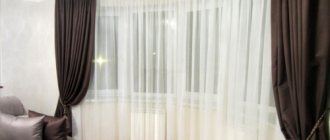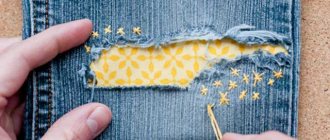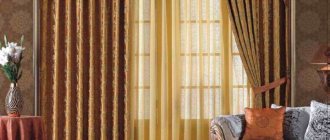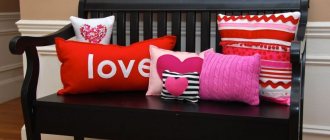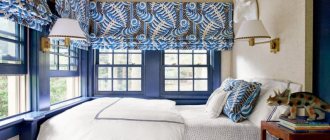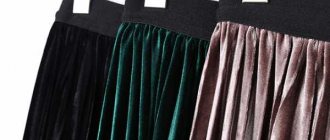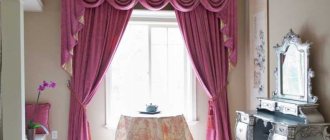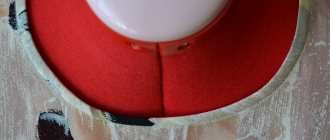What it is
Simply put, drapery is the process of giving fabric and other textiles a voluminous shape when assembled. If you dig deeper, you will find that there are many types of design. Here are some of them:
- Tying with a cord or ribbon is the easiest option;
- Drapery with ribbons and laces attached to holders or tiebacks at certain points;
Draping fabric
- Creation of unique even folds, which can be one-sided, multi-sided, bow-shaped, etc.;
- In horizontal form using hanging mechanisms;
- Creating drapery patterns using patterns.
Beautiful ceiling drapery
Important! The last method of making patterns may differ and depends on the type of fabric, the final shape of the decorative element, and the density of the assembly. Coarse textiles need to be collected more rarely. Less dense - less rough and often. In any case, before installation you need to make sketches of future solutions.
Suitable material for draping
The pattern depends on many parameters, including: calculating pattern values, adding hems, using ribbons and cords, and suspenders. It should be understood that the pattern of curtain fabrics and their details, including cascades, swags and ties, is more complex than sewing a simple curtain.
You also need to understand that you can’t create spectacular drapery from just any fabric. Some fabrics will not allow you to lay it out quickly and easily. For example, it is advisable not to drape knitted fabrics, as they can stretch greatly and the finished product will change shape. Rough and heavy materials are difficult to drape.
Door decoration
Despite all this, the choice of materials that will drape well is great. They should be selected based on the purpose of the product. For example, light and airy textiles are used for curtains, and heavier ones for curtains. The fabric is ideal for draping and can be easily assembled into gathers without special tools. Such fabric should not be too heavy or stretchy, hard or soft.
You may be interested in Sewing a patchwork bedspread in the patchwork style with your own hands
Skirt
Important! When choosing a material for drapery, you need to take into account not only its properties, but also the overall design of the room. The finished elements should look good and harmonious against the general background, emphasizing it.
Decorated area
A short
Mini length has been setting the fashion tone since spring 2020. Short dresses are designed for women who “have something to show.” Such models emphasize the elegance of women's legs, and light draperies on the dress help to hide imperfections in other parts of the body. Girls with an ideal figure can choose a dress with slight pleats in the hips, waist, or along the entire length of the dress.
©jeanettemadsen/Instagram
A dress with voluminous fabric drapery and an elegant train - for evening outings. Luxurious models of spring-summer dresses 2021-2022 were presented by the designers of the Cong Tri fashion house, take a look at the photo.
Drapery in clothes
Drapery in clothing is an element of its decoration and modeling, which can emphasize an ideal figure or neatly hide its flaws, transform it. There is not a single fashion designer who would not resort to using this technique in their collections.
How to beautifully make drapery fabric for clothes
Regarding clothing, pleasant and light drapery is obtained when using thin fabrics such as cambric, chiffon, muslin, heavy - on silk, knitwear and viscose, and voluminous - on textured fabrics that hold their shape.
Fashionable draped clothing
Important! This element of clothing modeling has long migrated from dresses and skirts to overalls and pullovers. Even tops are now draped using the latest fabric technologies.
Folds on the dress
Exclusive design of skirts with draperies
Sewing a straight cut product is easy. But in order to develop a style with folds that can be positioned in any direction, you will have to devote enough time to constructing a drawing, taking into account all the nuances. Additional elements are often used as drapery. They are cut out separately, and then overlapped and sewn. This is an easy method; it does not require any special design skills from the dressmaker.
Do you want to get a gorgeous visual effect without resorting to complex constructions? Place uneven folds along the waist and make changes in length. The outrageous skirt in the style of Vivienne Westwood is ready. This is a great way to express yourself and follow modern fashion.
Even in a business wardrobe, draperies are appropriate. A pencil skirt is not the only option for office wear. Folds can be placed horizontally, vertically or diagonally, on the front or back of the product. The main thing is that there are not too many of them. Moderation should prevail in a business wardrobe. Voluminous draperies are suitable for creating an evening outfit.
Draping curtains
Window decoration occupies one of the key places in creating the interior of a home. At the same time, no windows are complete without curtains. To create the perfect design element in the form of curtains, you need to understand what types of drapery there are. Highlight:
- Classic, neoclassical, baroque. Luxury and high-cost styles. Curtains are made from expensive textiles such as velvet, moire, silk, etc. The canvases are decorated with fringe, lace, cords, tiebacks and holders;
- Modern style. Based on the simplest draperies and curtains in light colors;
- Art Deco style. Good and expensive fabrics with large patterns and good borders. The contrast of bright and dark colors is characteristic;
- Provence, country. These styles are characterized by maximum simplicity and the use of natural fabrics such as silk, linen or cotton. The curtains are presented with simple folds and tiebacks.
Curtains
Drapery
The method of draping (draping) in figurative arts changed according to their state in different historical eras and among different peoples. The ancient Egyptians, Chaldeans, Persians and Phoenicians, as well as the Greeks, in their first attempts at artistic creativity, dressed statues and bas-relief figures in heavy, rough draperies, devoid of folds and similar to bags, from which only the head, arms and legs protruded. With further successes of Greek sculpture, draperies began to be split into folds, still dry and sharp, sometimes too numerous and laid out in regular rows, but already hinting at the contours of the body hidden beneath them.
In the era of the full flowering of Hellenic art, the gods and heroes, personified by plastic art in ideally beautiful images, for the most part throw off all sorts of veils; a lot if a piece of fabric is carelessly thrown over their shoulder or arm or lies next to them, and only such strict and chaste goddesses as Artemis and Athena do not part with the draperies, which then take on soft, graceful, cleverly placed folds.
However, along with naked and semi-nude statues, the art of this era also produces those clothed in draperies with numerous, symmetrical, as if ironed folds; but such statues are nothing more than “Old Believers”, imitation of the most ancient prototypes, consecrated by popular respect (archaistic statues).
Ancient Rome
For the Romans, the main task of plastic art was a portrait, which conveyed not only the features of a given person, but also his costume; the clothes of the Romans and Roman women - the togas of senators and priests, the tables and peplums of matrons, the cloaks of warriors, the robes of emperors and others - represented a rewarding topic for artistic development. As a result, the Roman sculptors brought the art of drapery to a high degree of perfection and left us the best examples in this area.
Middle Ages
In the Middle Ages, with a general decline in the arts, drapery returned almost to primitive rudeness and clumsiness, and only Byzantium still retained some traces of ancient tradition in relation to them. By the XII and XIII centuries. in the west of Europe, skinny, stiff statues with huge heads cling to pilasters and to the jambs of church portals in clothes with clumsily chopped, frequent folds located without any consideration, falling down vertically or breaking at sharp angles.
In the 14th century, some success was noticeable: draperies began to become less rigid and hint at the shape of the body hidden beneath them. In the 15th century, they freed themselves even more from convention and routine, striving to outline the figure as best as possible, although sometimes they indulge in mannerisms.
Renaissance
The beginning of the 16th century coincides with the brilliant development of this branch of art, just like all others: careful study of antiquities and nature gives Renaissance artists the opportunity to enhance both in sculpture and painting the beauty and expressiveness of the human figure with soft, graceful, completely natural draperies and to equal, if not surpass, the artists of classical antiquity in this respect.
In the following centuries, in both branches of art, drapery is often given too important a role, and, while pretending to be beautiful, they break, crumple and flutter in the most implausible way. This affectation ceases at the end of the 18th century under the influence of passion for the ancient Greeks and Romans, excited, on the one hand, by the preaching of Winckelmann, and on the other, by the school of the French. painter David.
19th century
At this time, loose and wide draperies like the ancient ones have not yet been completely forced out of art by the ungrateful modern costume, and sculptors often resort to them, especially when they have to create monumental statues. In art schools, young artists and sculptors learn how to arrange drapery with the help of suitably dressed mannequins.
XX century
| This section is not completed. You will help the project by correcting and expanding it. |
Wall drapery
This kind of wall decoration is rare and usually temporary. When using this type of decor, there are a number of advantages:
- Possibility of installation without construction experience;
- No need to treat walls before installation;
- Effectively concealing wall defects;
- Soundproofing;
- No damage to walls during installation.
You may be interested in: How to properly sew elastic bands to clothing fabric
Important! Modern wall solutions are woven from materials that are resistant to fading, dust and moisture.
Walls
There are also disadvantages of some fabrics when used in this way. For example, pile fabrics, despite impregnation, accumulate a large amount of dust, and in a bathroom or other damp room, even moisture-resistant fabric will sooner or later become damp.
General recommendations for decor are as follows: do not use fabric on the walls in children's rooms, as well as in corridors. This solution is not suitable for poorly ventilated areas. The fabric is usually secured to wooden or metal bases for easy removal and washing.
Draped decoration
Ceiling drapery
One of the oldest types of decoration, which was used in ancient times as a work of art. The fabric can be located on the ceiling in the form of a plane of straight lines, a cone of rectangles, covering the entire surface or parts of it.
Draping the ceiling with textiles has the same advantages as draping walls, but the disadvantages of this approach are much more serious:
- The height of the draped ceiling is noticeably reduced;
- Such decor is difficult to fit into the overall interior;
- The risk of fire increases as the fabric is highly flammable;
- Washing and putting away such a canvas is more difficult than hanging on the wall.
This kind of ceiling is inappropriate in kitchens, bathrooms and children's rooms.
Ceiling
Door drapery
Textiles of such shapes are used both instead of doors as curtains on the doorway, and inside the doors themselves, most often glass. In the first case, the type of fabric, its color and shape must exactly replicate the appearance of the fabric on the windows. Door inserts are used not only for interior doors, but also for decorating cabinet doors.
In many cases, using draped textiles in openings instead of massive doors is more profitable and more pleasing to the eye.
You may be interested in this: Simple patterns of denim jackets for sewing yourself
Important! This solution should be used where there is no need to insulate the room. For example, between the living room and the hallway, the bedroom and the office, etc.
Doors
Types of draperies
Draping
is the oldest method of clothing modeling, which involves working with the plasticity of fabric and creating new forms. Draperies are very diverse, and for ease of understanding I will divide them into several types.
In general, two large groups of draperies can be distinguished:
Loose draperies
- these are those that are formed by the fabric itself. Very roughly the essence is a single piece of cloth wrapped beautifully around the body. This includes ancient clothing as seen in sculptures (togas, tunics, etc.). In its modern form, these are all kinds of tunics, circle/square dresses, transformable dresses with several tying options, etc.
Static draperies
- these are those that are fixed inside the structure of the clothing, and they do not change their shape, or do not change significantly (“sway” in movement, but the drapery itself always has the same appearance). This group is very, very numerous; it includes folds, gathers, puffs, figured draperies, swings, large and small details. Such draperies can be soft or hard. But the essence is the same - the drapery is a separate processed unit inside the suit.
Among the first couturiers who worked with draperies in the last century are Balenciaga and Vionne. Now, in modern times, draperies mainly relate to evening and wedding fashion. It is rare to see complex draperies in everyday wear. The most common ones now are the “swing” drapery and drapery on the chest in wrap dresses.
Of the static draperies, I will additionally distinguish two groups, according to the principle of their production:
- Constructive draperies.
We will include among them those parts that were obtained through constructive modeling (transfers of darts, flaring of parts). Such draperies create the desired volume (for example, for the chest) and themselves adhere to the figure due to connection with adjacent parts. For example, consider the draping on a red velvet dress. How was it obtained? The chest dart was moved to the side at an angle and gathered. It holds up on its own, without lining, without any fastening, due to the fact that nothing has changed structurally; the fit that was built into the design remains the same. That is, drapery in this case primarily has a formative function, and only then a decorative one.
Drapery of arches
These are the same openings, but in the form of arches. Doors are most often not installed on them due to their shape. Therefore, you can embellish the openings with draped fabric. Depending on the type of arch (interior, window, door), the drapery style is also chosen.
For arches in window openings, drapery solutions are as follows:
- Throw it over the arch on the eaves with a low room height;
- Fasten under the bend of the arch on a regular cornice to emphasize its beauty;
- In the form of a bend using a flexible cornice;
- Attached along the curve for added lightness.
For arched window openings, you can use roller blinds and curtains with tiebacks for light muslin.
Decorating an arched interior opening follows the same rules as the drapery of ordinary doors: its style should repeat the style of window drapery.
Arches
Drapery in art
Folds in fabric are one of the main elements in fine art. But they rarely take center stage. Drapery complements and fills the picture with liveliness, gives volume to clothes and canvas. For example, the artist Rafael depicts his Madonnas wrapped in folds of fabric. Jan Van Deik and the famous painting “Portrait of the Arnolfini Couple”, Botticelli’s “Birth of Venus” or “Spring” are just a few examples of paintings where the drapery of fabric is conveyed. This list can be continued with portraits from the Renaissance until the end of the 11th century. Religiously inspired iconography and art painting also often dress saints in draped robes.
In sculpture, draped clothes are found in bas-reliefs and statues of antiquity and the Renaissance (statues of Athena, Venus, Demeter, young Dionysus and many others). This is one of the main elements in the transmission of images of ancient Greek and Roman gods and heroes. But not only antique motifs depict draped fabric on the body, you can also often find busts and sculptures depicting a face covered with a veil or a body in the folds of thin fabric (Antonio Korradini “Viled Lady”, Rafal Monte ) “Vestal Virgin”, sculpture “Ondine emerging from the water” and others).
Folds of fabric have found their place in architecture. Ionic antique columns were created by architects inspired by the female silhouette in draped clothes.
Tent drapery
If the ceilings in the room are very high, then you can create a decor in the form of a draped tent. In this case, you need to use additional decorative elements to emphasize the ceiling.
Another option would be to create a tent in the bedroom near or above the bed. The essence of the installation will remain the same: it is necessary to determine the height of the ceiling and the general style of the interior of the room.
Tent
Important! Not so long ago, decorating the site of cafes and restaurants for corporate parties and events, such as weddings, in the form of a tent has become widespread. This is not the cheapest decor option and it requires a huge amount of textiles, but it makes an amazing impression.
House tent
Textile drapery is one of the most important design elements, creating unique, harmonious and fashionable interiors. The most important thing is to take into account the purpose of the room, its original design and furniture, the size of the ceiling, windows and openings.
